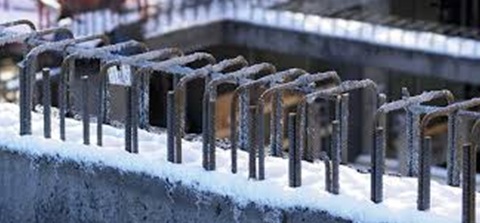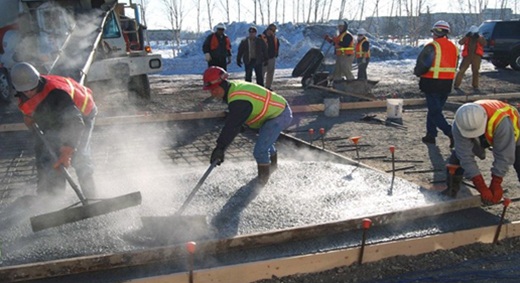INTRODUCTION
The period developed when the mean day to day temperature falls below 40 C for more than three consecutive days is called cold weather and the concreting done in that period is referred to as cold weather concreting. However, special conditions are to be maintained when finishing, placing, curing, and protecting concrete from severe weather conditions. As during winter conditions can change abruptly, better planning in execution of the work is essential.
When concrete is in plastic state and it freezes, then strength reduces by 50% which in turn affects its durability and workability. Hence, it should be protected from freezing until it attains a minimum of 3.5 MPa.
When concrete is at low temperature, it affects greatly the setting time and rate of gain of strength due to hydration process being hindered. In this case, a thumb rule can be applied which indicates that a drop of temperature in concrete by 100 c will lead to increase in setting time of concrete by twice. This will affect the formwork removal time and will create a problem at construction site.
All these factors play a great role in cold weather concreting.

Fig 1: Freezing of concrete creating problems at site
COURTESY: THE VIRGINIA READY MIXED CONCRETE ASSOCIATION
REMEDIES FOR COLD WEATHER CONCRETING
Some of the remedies are –
- Calcium carbonate can be added to avoid carbonation in concrete during cold weather concreting.
- Average daily temperature should be maintained below 100 C as much as possible.
- Admixtures can be added to increase the setting time in case the concrete exceeds the temperature as given in above point.
- When freezing, temperature is reached, ready mix concrete can be used. Most plants try to have the concrete temperature at 65°F when it leaves the plant. This is generally preferred depending upon air temperature and thickness of the concrete element.
- Slump should be acquired at less than 4 inches for better workability in the field.
- Air entrained concrete can be used to reduce bleeding conditions in concrete.
- In order to delay the setting time, calcium chloride can be added at about 2% by weight of cement so as to accelerate the hydration reaction. It is easy and economical. But care should be taken not to give overdose as excess dosage can lead to corrosion in reinforcements.
- Accelerators are not anti-freezing agents, but can lead to problems as specified above. Hence, non-chloride can be applied as they don’t lead to discoloration in concrete but at the same time they are expensive.
- Fly ash and slag cement should be strictly avoided in cold conditions as they have longer setting time and generate less internal heat leading to low heat of hydration.
- Ready-mix producer can be added to produce some extra cement (typically an extra 100 pounds per cubic yard) to make the concrete hotter.
- Type III (high-early strength) cement can also be addedas it hydrates more rapidly.
- Care should be taken while using water reducers as these can increase the setting time. Also, it is often neededto have water reduction with cooler concrete since the cooler temperatures prevents slump loss.
- When admixtures freeze at the construction site, they must not be used at the chemicals may have been separated and the addition of these might worsen the concrete condition.
- Heated enclosures are quite good in protecting concrete in cold weather, but these are very expensive. Enclosures made of wood, polyethylene or canvas tarpaulins can be used in such cases. Prefabricated rigid-plastic enclosures are also available that can be used extensively, but again they are costly.
- Windbreaks of six feet can be used that protect the construction personnel and concrete from winds that lead to drop in temperature and cause excessive evaporation. These could be tall or short depending on wind velocities, ambient temperatures, relative humidity, planning technique and concrete placement temperatures.
- Concrete should not be allowed to freeze during the first 24 hours starting from the time it was placed. Since cement hydration is an exothermic reaction, the concrete mixture produces some heat on its own which can be trapped using polyethylene sheeting or insulating blankets.In extreme conditions, it may be required to supplemental heat.
- Rapid hardening cement can be used as it contains more C3S which is responsible for quick setting of cement.
- ACI Committee 308 has recommended the following minimum curing periods which should be followed:
ASTM C 150 Type I cement, 7 days
ASTM C 150 Type II cement, 10 days
ASTM C 150 Type III cement, 3 days
ASTM C 150 Type IV or V cement, 14 days
ASTM C 595, C 845, C 1157 cements, variable - Seal newly cured concrete by applying sealant to prevent outside water from seeping into the concrete. Concrete sealants will extend concrete’s life and will reduce the chance of curing failure. In extremely cold regions, use only a breathable concrete sealant that allows the evaporation of moisture.

Fig 2: Cold weather concreting done at site
COURTESY: KUHLMAN COPERATION
CONCLUSION
During cold weather concreting, it becomes difficult to maintain the correct temperature required for curing and setting. All these preventive measures can help to a great extentbut care should be taken to control the temperature as much as possible. In extreme cases, the concreting can be stopped as quality is important. In such conditions, the construction equipment must work in rapid rate for continuous mixing so that concrete doesn’t freeze. Moreover, cements like rapid hardening can be used to remove formwork within a very small amount of time. It is highly recommended to use cements as per code standards so as to have durability, strength and required hydration in cement.
REFERENCES
• Portland Cement Associations, “What Happens When Concrete Freezes?”- https://www.cement.org/learn/concrete-technology/concrete-construction/cold-weather-concreting
• Nevada Ready Mix, “Cold Weather Concreting – What, Why and How?”- https://www.nevadareadymix.com/concrete-tips/cold-weather-concreting/
• ConcreteNetwork.com, “WHY IS COLD WEATHER A PROBLEM WHEN POURING CONCRETE?”- https://www.concretenetwork.com/cold-weather-concrete/weather.html
• Buildings Solution Group, “What factors are important during hot – and cold – weather concrete placement?”- https://builderssolutiongroup.blogspot.com/2014/04/what-factors-are-important-during-hot.html
• The balance small business, “Tips for Curing Concrete in Cold Weather”-
https://www.thebalancesmb.com/expert-tips-on-how-to-cure-concrete-in-cold-weather-845024
If you have a query, you can ask a question here.



Amazing explanation on this topic.